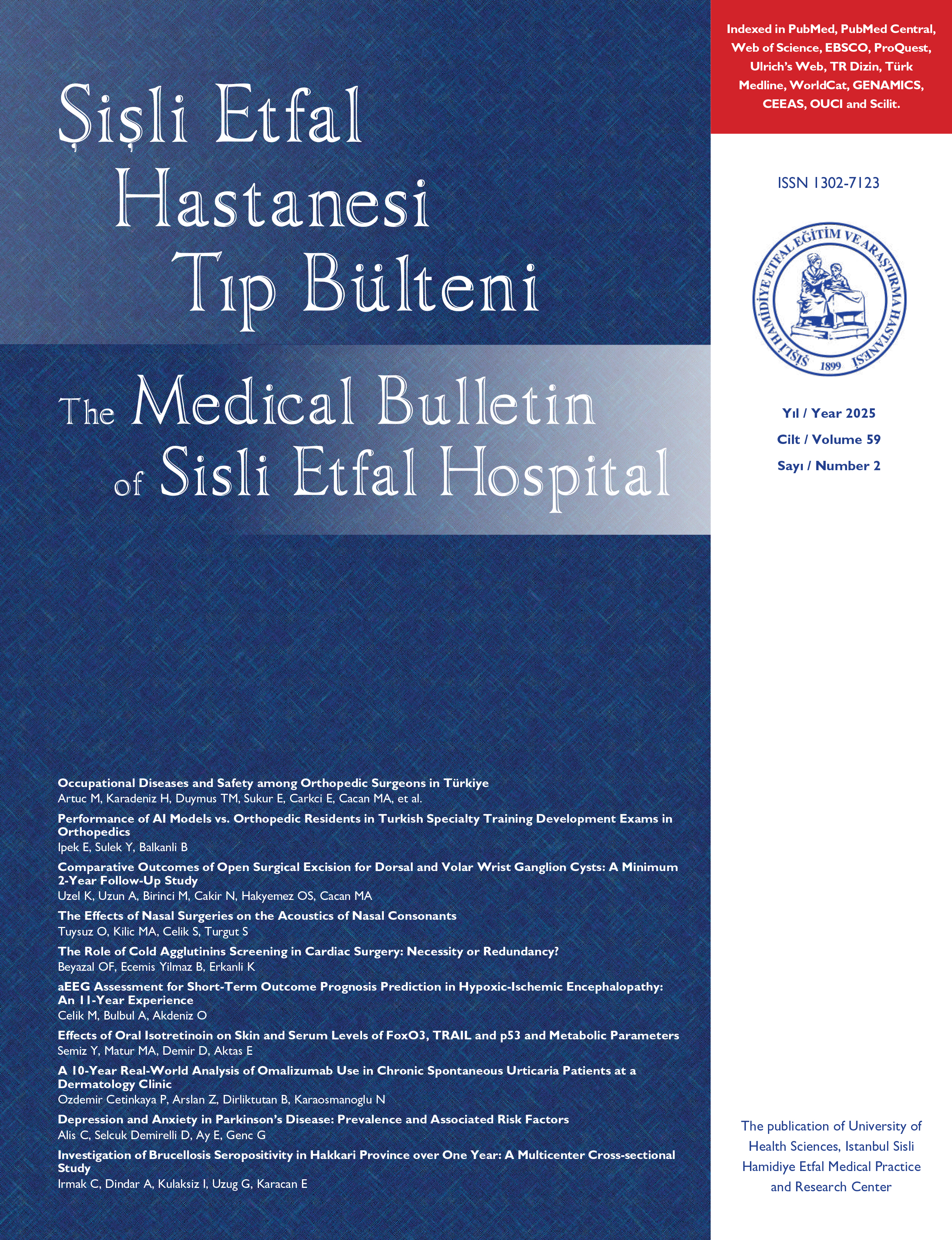
Anatomical, Functional, and Dynamic Evidences Obtained by Intraoperative Neuromonitoring Improving the Standards of Thyroidectomy
Nurcihan Aygun1, Mehmet Kostek1, Adnan Isgor2, Mehmet Uludag11Department of General Surgery, University of Health Sciences Turkey, Sisli Hamidiye Etfal Teaching and Research Hospital, Istanbul, Turkey2Department of General Surgery, Bahcesehir University Faculty of Medicine, Istanbul; Sisli Memorial Hospital, Istanbul, Turkey
The use of intraoperative neuromonitoring (IONM) is getting more common in thyroidectomy. The data obtained by the usage of IONM regarding the laryngeal nerves anatomy and function have provided important contributions for improving the standards of the thyroidectomy. These evidences obtained through IONM increase the rate of detection and visual identification of recurrent laryngeal nerve (RLN) as well as the detection rate of extralaryngeal branches which are the most common anatomic variations of RLN. IONM helps early identification and preservation of the non-recurrent laryngeal nerve. Crucial knowledge has been acquired regarding the complex innervation pattern of the larynx. Extralaryngeal branches of the RLN may contribute to the motor innervation of the cricothyroid muscle (CTM). Anterior branch of the extralaryngeal branching RLN has always motor function and gives motor branches both to the abductor and adductor muscles. In addition, up to 18% of posterior branches may have adductor and/or abductor motor fibers. In 7080% of cases, external branch of superior laryngeal nerve (EBSLN) provides motor innervation to the anterior 1/3 of the thyroarytenoid muscle which is the main adductor of the vocal cord through the human communicating nerve. Furthermore, approximately 1/3 of the cases, EBSLN may contribute to the innervation of posterior cricoarytenoid muscle which is the main abductor of ipsilateral vocal cord. RLN and/or EBSLN together with pharyngeal plexus usually contribute to the motor innervation of cricopharyngeal muscle that is the main component of upper esophageal sphincter. Traction trauma is the most common reason of RLN injuries and constitutes of 6793% of cases. More than 50% of EBSLN injuries are caused by nerve transection. A specific point of injury on RLN can be detected in Type 1 (segmental) injury, however, Type 2 (global) injury is the loss of signal (LOS) throughout ipsilateral vagus-RLN axis and there is no electrophysiologically detectable point of injury. Vocal cord paralysis (VCP) develops in 7080% of cases when LOS persists or incomplete recovery of signal occurs after waiting for 20 min. In case of complete recovery of signal, VCP is not expected. VCP is temporary in patients with incomplete recovery of signal and permanent VCP is not anticipated. Visual changes may be seen in only 15% of RLN injuries, on the other hand, IONM detects 100% of RLN injuries. IONM can prevent bilateral VCP. Continuous IONM (C-IONM) is a method in which functional integrity of vagus-RLN axis is evaluated in real time and C-IONM is superior to intermittent IONM (I-IONM). During upper pole dissection, IONM makes significant contributions to the visual and functional identification of EBSLN. Routine use of IONM may minimalize the risk of nerve injury. Reduction of amplitude more than 50% on CTM is related with poor voice outcome.
Keywords: Intraoperative monitoring, laryngeal nerve injuries; recurrent laryngeal nerve; thyroidectomy, vocal cordTirodektomi standartlarını geliştiren intraoperatif nöromonitörizasyon ile elde edilen anatomik, fonksiyonel ve dinamik kanıtlar
Nurcihan Aygun1, Mehmet Kostek1, Adnan Isgor2, Mehmet Uludag11Sağlık Bilimleri Üniversitesi Şişli Hamidiye Etfal Eğitim ve Araştırma Hastanesi Genel Cerrahi Anabilim Dalı, İstanbul2Bahçeşehir Üniversitesi Tıp Fakültesi Genel Cerrahi Anabilim Dalı, İstanbul; Şişli Memorial Hastanesi, İstanbul
Tiroidektomide intraoperatif sinir monitörizasyonu (IONM) kullanımı giderek artmaktadır. IONM ile laringeal sinirlerin anatomisi ve sinir yaralanmaları ile ilgili birçok veri elde edilmiş ve bunlar tiroidektomi standartlarının artışına önemli katkı sağlamıştır. Bu kanıtlar: Rekürren laringeal sinirin (RLN) saptanmasını, vizual identifikasyonunu arttırmaktadır. RLNnin en sık anatomik varyasyonu ekstralaringeal dalların saptanma oranını arttırmaktadır. Nonreküren laringeal sinirin erken saptanmasını ve korunmasını sağlamaktadır. Larinksin kompleks motor inervasyonu ile ilgili önemli veriler elde edilmiştir. RLN veya ekstralaringeal RLN dalları krikotiroid kasın motor inervasyonuna katkı sağlayabilir. Ekstralaringeal dallanan RLNlerin ön dalı sürekli motor fonksiyona sahip olmakta ve hem abduktor hem de adduktor kaslara motor lifler vermektedir. Buna ek olarak %18a kadar posterior dallarda da adduktor ve/veya abduktor motor lifler içerebilir. SLSE %70-80 oranında insan birleştirici siniri yoluyla vokal kordun ana addüktörü tiroaritenoid kasın 1/3 anterioruna motor inervasyon sağlamaktadır. SLSE yaklaşık vakaların 1/3ünde ipsilateral vokal kordun ana abdüktör kası olan posterior krikoaritenoid kas inervasyonuna da katkı sağlamaktadır. Üst özefageal sfinkterin major komponenti olan krikofaringeal kasın motor inervasyonunu faringeal pleksusa ek olarak genellikle RLN ve/veya SLSE katkı sağlamaktadır. RLN yaralanmalarının %67-93ü oranında en sık nedeni traksiyon travmasıdır. SLSE yaralanmalarının %50sinden fazlası sinir kesisidir. RLN yaralanması durumunda sinir üzerinde spesifik bir yaralanma noktasının olduğu durum tip 1 (segmental) sinyal kaybı olup, yaralanma sonrasında elektrofizyolojik olarak saptanabilen bir hasar noktası olmadığında ipsilateral vagus-RLN aksı boyunca sinyal kaybının olması tip 2 (global) yaralanmadır. Sinyal kaybı gelişir ise 20 dakika beklendiğinde sinyal kaybı persiste eder veya inkomplet sinyal iyileşmesi olursa %70-80 vokal kord paralizisi (VCP) gelişir, komplet sinyal iyileşmesinde VCP gelişmez. İnkomplet sinyal iyileşmesi olan hastalarda VCP geçici olup, kalıcı VCP görülmemektedir. RLN yaralanmalarının %15inde vizual değişiklik varken, IONM RLN yaralanmaların %100ünü saptayabilir. IONM bilateral VCPyi önleyebilir. Sürekli IONM (C-IONM) vagus/RLN aksının fonksiyonel bütünlüğünün gerçek zamanlı değerlendirildiği aralıklı IONMye gore daha üstün bir yöntemdir. Üst pol diseksiyonu sırasında IONM SLSEnin vizual ve fonksiyonel belirlenmesine anlamlı katkı sağlamaktadır. IONMnin rutin kullanılması sinir yaralanma riskini minimalize edebilir. Krikotiroid kas amplitüdünde %50den fazla düşme hastanın kötü ses sonuçları ile ilişkilidir. (SETB-2021-05-159)
Anahtar Kelimeler: intraoperatif monitörizasyon, tiroidektomi; rekürren laringeal sinir; laringeal sinir yaralanmalarıManuscript Language: English



















